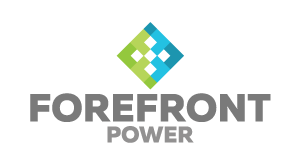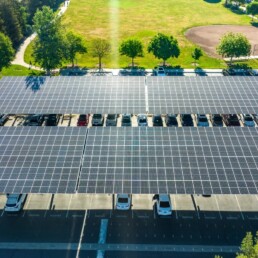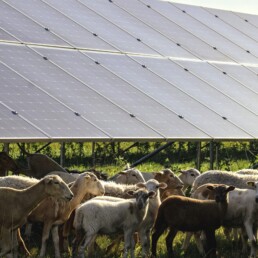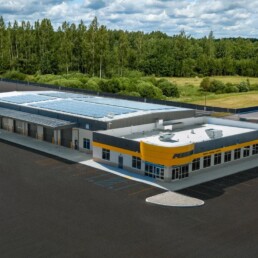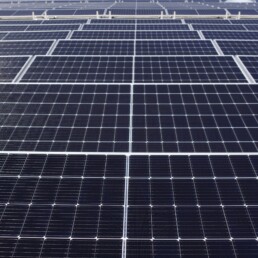
Wildfire Season – What has happened in the last couple of years?
California is currently battling some of the largest wildfires in history, with over a million acres of land burned thus far. On August 17th, a series of lightning strikes from a storm system started hundreds of fires across Northern California, which, at the time, was experiencing a heatwave in addition to another prolonged dry season.
Wildfire season typically occurs from August to November when weather conditions are at their warmest and driest. It has been proven that the driving sources behind many wildfires are due to drowned power lines, electrical malfunctions, extremely dry and warm conditions, or a combination of all. With the persistence of all these fire-starting factors, it seems that more wildfires are on the horizon in the future.
Large Wildfires Across California (August 2020)
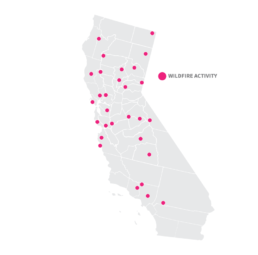
As California continues to experience devastating wildfires, more and more businesses and residents find themselves without a secure power source experience. These measurements to shut off the grid to mitigate and control fire potential in high-risk fire zones are called Public Safety Power Shutoffs (PSPS). Previous wildfire seasons have left hundreds of thousands of customers without power and had damaging repercussions on the economy and public health. The severity of last year’s fires resulted in a 2019 Public Safety Power Shutoff that affected approximately 800,000 customers in California, leaving many without a secure power source for days.
The damages caused by wildfires confirm the need for a secure source of energy generation to protect communities, homes, and businesses from electrical failure. Solar, storage, and microgrids can help meet growing demands and increase resiliency for you, especially in the face of emergencies and Public Safety Power Shutoffs.
How can renewable energy help keep your organization resilient?
With the grid up and running, solar will produce electricity when the sun is shining, and energy storage will store and dispatch that electricity to help the balance between electricity generation and demand. However, during a grid outage, a normal solar and storage system will shut down to prevent the backflow of electricity onto the grid.
In addition to solar and energy storage, we also have microgrids. Microgrids are a revolutionary way to provide a secure source of energy during grid outages. With a microgrid, intelligent controllers sense the utility grid outage, switch the on-site generation into islanding mode, and allow the solar and storage to continue to power your facility.
Thus, your facility can sustain uninterrupted operations even when other nearby facilities are without power.
How much funding and incentives are available for my organization in California?
Federal Incentive Tax Credit (ITC)
If you aren’t familiar with the ITC, here’s a brief overview. In 2005 Congress passed the Energy Policy Act, creating a 30 percent investment tax credit (ITC) for residential and commercial solar energy systems. These credits created a major boon for the solar industry, helping to grow annual solar installations by over 1,600 percent since its implementation – an annual growth rate of 76%! The ITC is a dollar for dollar reduction in taxes that the project sponsor benefits from. Meaning, those that buy solar systems can today get the system for 26% off the sticker price and pay their systems off sooner. This is a huge incentive for home and business owners looking to reduce their tax liability.
Public entities, such as schools, cities, and municipalities, were originally unable to benefit from this discount because of their lack of tax liability. Through Power Purchase Agreements (PPAs), Public Agencies can realize the benefits of the tax credits in the form of a lower energy rate from their PPA provider.
Self-Generation Incentive Program (SGIP)
The Self-Generation Incentive Program (SGIP) provides rebates to customers who install clean energy technologies – including energy storage – to serve their own loads. The SGIP program funds energy storage projects that are either standalone or paired with solar. Because funding for the program is collected from surcharges on the customer bills of electric and gas investor-owned utilities, SGIP covers nearly the entire state.
SGIP Resilient Budget
Increased incentive levels apply to certain customer types, including cities, counties and educational facilities that are located in low-income or disadvantaged areas. ForeFront Power will evaluate the eligibility of your facility to maximize your incentive amounts and manage the application process for you.

ForeFront News
November 25, 2024
Agrivoltaics in Ames: Solar Energy Meets Sheep Grazing
November 18, 2024
Penske Truck Leasing Lights Up New Solar-Powered Facility Initiative
October 23, 2024
Building Solar and Minds with Bakersfield College
September 26, 2024
Rafiqui is born, the first solar panel recycler in Mexico
Interested in learning more?
We would love to discuss how our solutions might be a fit for your organization. Contact one of our solar, storage, or e-mobility experts today:
